Do you drink green tea every day? Read on to learn more about its history, types, benefits, and how to steep the perfect cup of green tea. Enjoy its sweet, earthy flavor and innumerable health benefits (Think Japanese lifespan!)
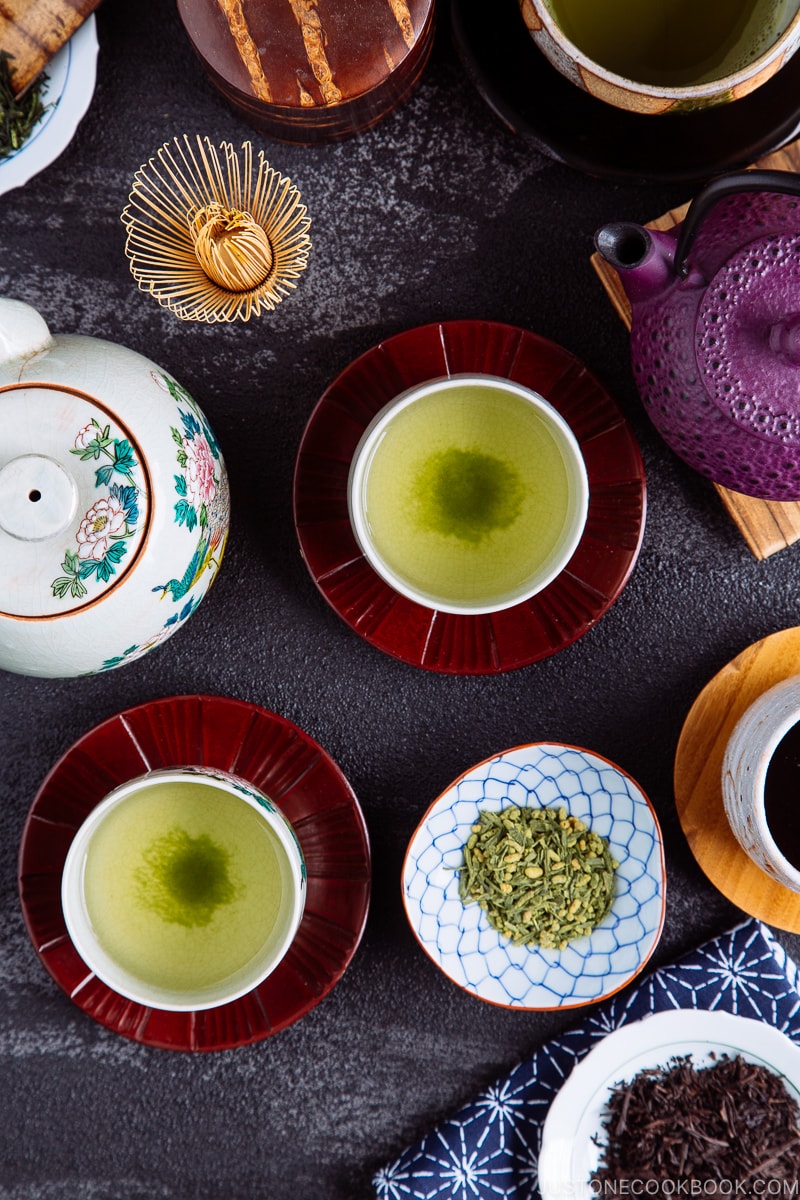
Green tea is synonymous with Japanese tea. It is the most consumed beverage in Japan, valued for its health and restorative properties. Drinking green tea (緑茶) is a custom that has been interwoven into Japanese culture, with almost every meal in Japan accompanied by a freshly brewed pot of green tea. It is a way of life and an embodiment of Japanese hospitality.
Before taking your next sip, let’s discuss the history of green tea, types of green tea, and the best way of drinking green tea for optimal health benefits.
Table of contents
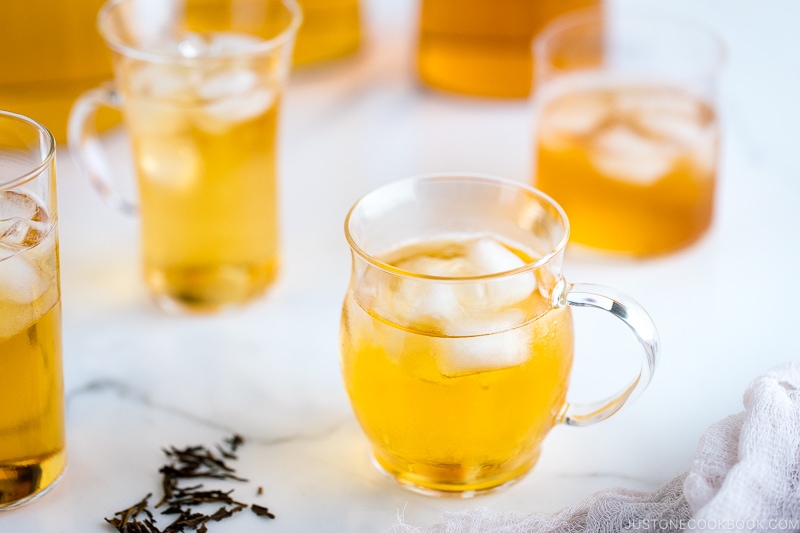
Brief History of Green Tea in Japan
Green tea was first introduced in Japan by Japanese monks who studied Buddhism in China during the Nara and Heian era over a thousand years ago. It was first enjoyed exclusively by the religious classes of Japanese society but spread to the royal and other elite classes as tea cultivation started in Japan.
In the 12th century, a Zen priest named Myouan Eisai, wrote a book called Kissayojoki (喫茶養生記), in which he talked in detail about tea cultivation, green tea preparation, and how beneficial green tea is for health and long life. The success of his book led to the emergence of shared tea culture in Japan, where all levels of Japanese society began to drink green tea and adopted it as a central part of their daily lives.
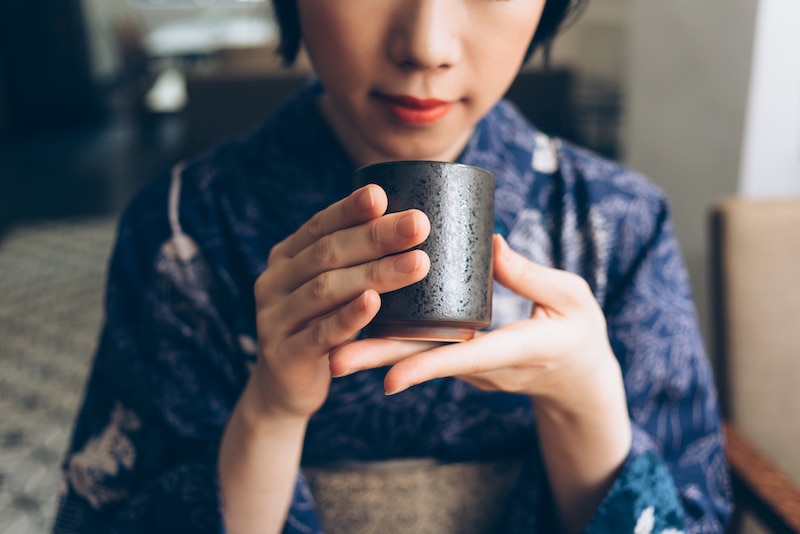
6 Types of Japanese Green Tea
Green tea and other tea like black tea, white tea, or oolong all come from an evergreen shrub called Camellia sinensis. What makes them different are how the tea leaves are cultivated and processed. Green tea retains its fresh color and delicate flavor because it is processed quickly to prevent oxidation—the tea leaves are steamed and dried almost immediately after being harvested.
There are various types of green tea, depending on the cultivation methods, growing conditions, as well as the steaming and drying process. Each type of green tea has its own characteristics and flavor, and here are just some of the classifications of green tea:
1. Sencha (煎茶)
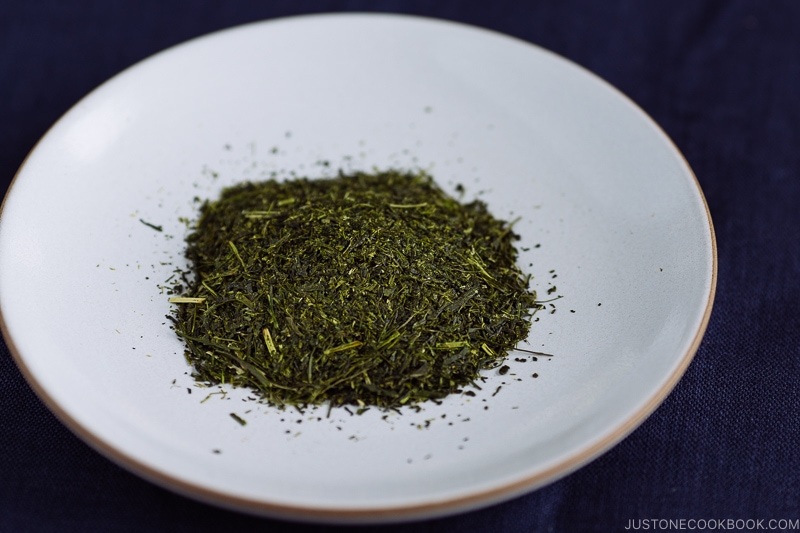
Sencha Fukamushi is the most common green tea consumed in Japan. It is produced by picking only the youngest tea leaves; these sencha leaves are then steamed, rolled, and dried. With a good balance of acidity and sweetness, sencha makes a great everyday tea.
2. Matcha Green Tea (抹茶)
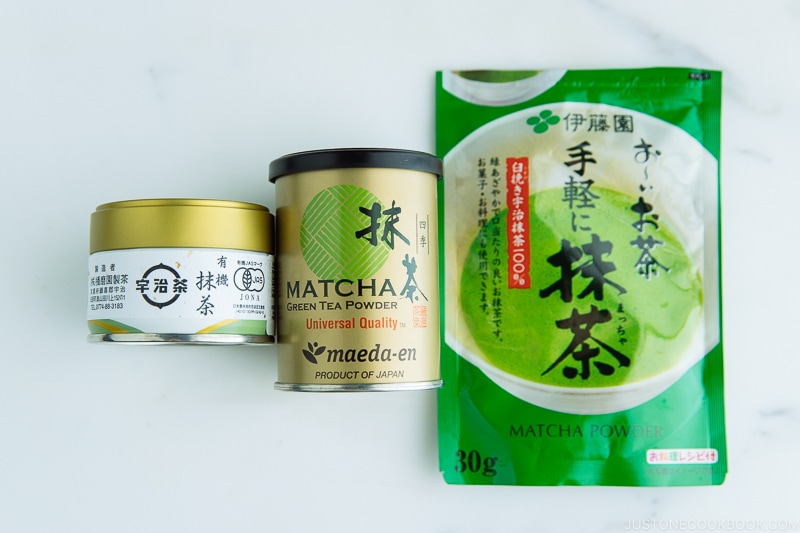
Recognized for its vivid green color, matcha is processed with high-quality tea leaves (known as tencha)—grown in the shade a few weeks before harvesting in order to strengthen the flavor and caffeine level. It is then processed into a very fine powder, which is traditionally used for Japanese tea ceremonies. The powder and water are placed in a bowl, and then whisked with a special type of whisk: a chasen. With a unique earthy flavor and unmistakable color, matcha has now become a sought-after ingredient in inventive modern cuisines and as a trendy flavoring in all sorts of wagashi (Japanese sweets) and western-style pastries.
👉🏼 You can read more about matcha and its uses here.
🍵 Matcha Recipes:
3. Gyokuro (玉露)
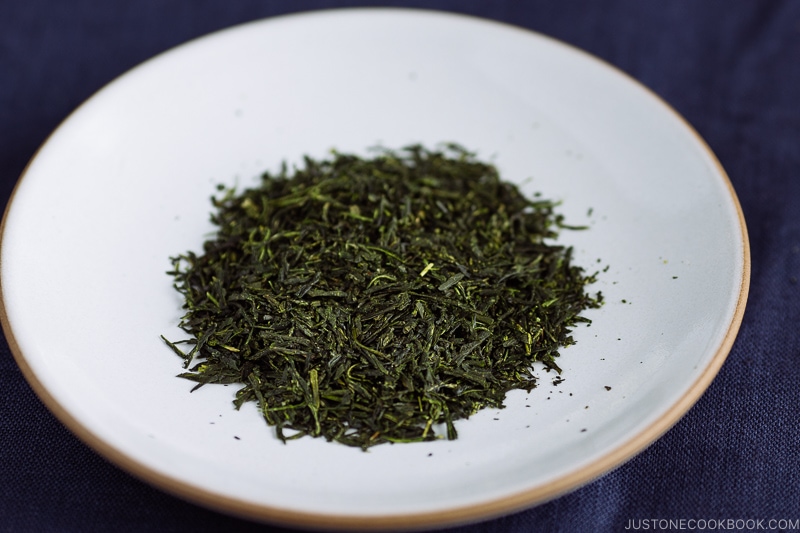
Gyokuro (or Jade Dew) is often viewed as the best quality green tea. Like the tea leaves used for matcha, gyokuro also uses shade-grown tea leaves, giving the tea a much more concentrated flavor. Some describe the taste as sweet and slightly seaweed-like. You can clearly distinguish the tea with its deep, dark green leaves and its unparalleled aroma. For any tea connoisseurs out there, and those who appreciate their tea with rich accents, gyokuro may be your tea of choice.
4. Hojicha (焙じ茶)
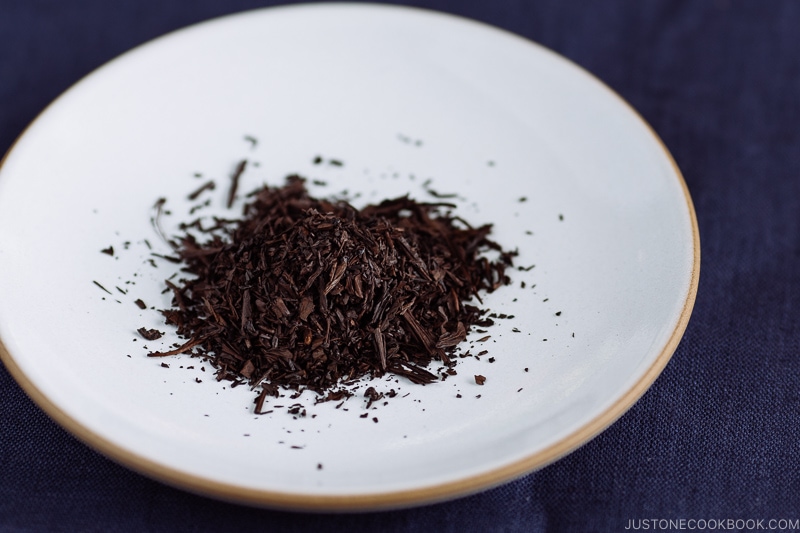
Hojicha is a green tea that has been toasted and chilled. The tea leaves have a reddish-brown color and a roasted aroma. Hojicha is mild tasting and has less caffeine, which makes it a wonderful tea to enjoy especially after a late, heavy dinner.
5. Genmaicha (玄米茶)
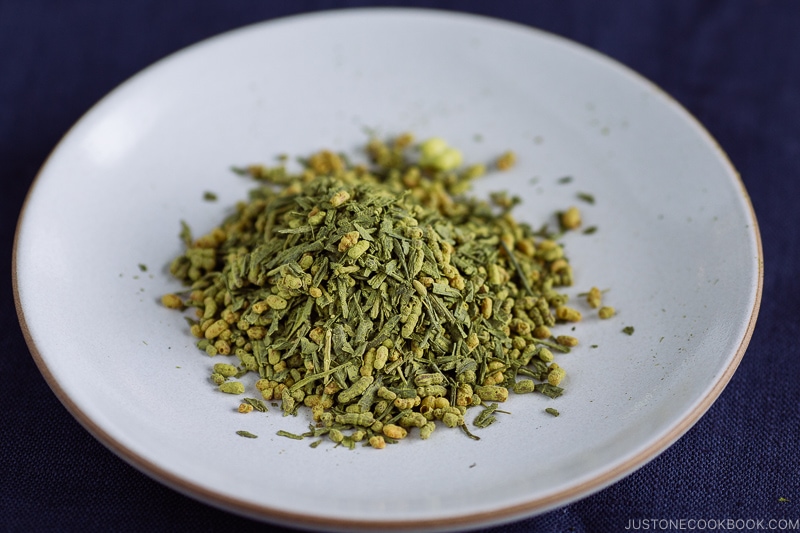
This traditional Japanese green tea is an interesting mix of a Sencha tea blended with toasted puffed brown rice, It gives the tea a distinctively toasted grain undertone. It’s a mild-flavored tea with an almost popcorn-like taste. An excellent choice for those who prefer low caffeine tea.
6. Others
In addition to the above common green teas, you can also some other interesting varieties which include Kukicha (twig tea), Ryokucha (a mix of steamed green tea and ground matcha), Bancha (harvested later in the season than Sencha), and Konacha (tea made from the leftover dust of Gyokuro or Sencha). I highly recommend looking into all the different types of Japanese green tea to find the one that suits your tastes the best.
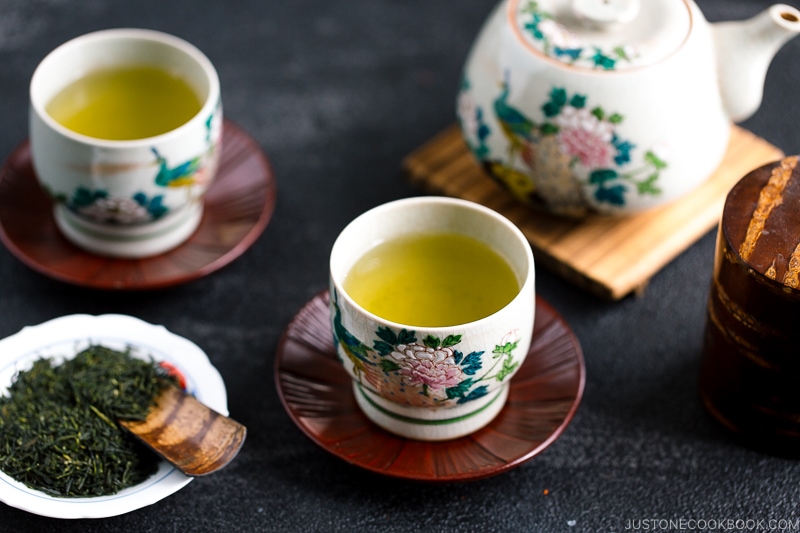
Health Benefits of Green Tea
Numerous research studies have found links between consuming the nutrients in green tea and lowering the risk of high blood pressure, inflammation, heart disease, and cancer.
While these studies are not definitive and there’s still much more to learn about green tea, here are some potential health benefits of green tea that have been brought forward:
1. Green tea contains antioxidants that improve overall health
As it is one of the least processed types of tea, green tea has high levels of antioxidants and bioactive compounds such as polyphenols, catechins, and other types of flavonoids. These beneficial compounds act as the same anti-aging compounds found in red wine, dark chocolate, and blueberries, which can fight free radicals, protecting cells and molecules from damage.
2. Green tea helps protect heart health
Drinking green tea regularly over a long period of time is said to help prevent many risk factors for heart-related diseases. A study published by the Journal of the American College of Nutrition found participants consuming five or more cups of green tea every day were less likely to develop hypertension or cardiovascular disease.
3. Green tea helps promote brain health
The flavonoids found in green tea can have protective effects on neurons, which can help lower the risk of Alzheimer’s disease and Parkinson’s disease. It also contains L-theanine, a unique amino acid that can work synergistically with caffeine to improve brain function.
4. Green tea and relaxation
For those of us who drink green tea daily, we would all agree on its meditative effect. There is something tranquil about sipping a fresh brew of green tea that reminds us to slow down and breathe. A study published in Trends in Food Science & Technology shows that L-theanine in green tea provides a calming and relaxing effect to the brain. With less caffeine than coffee, green tea is a great alternative to increase alertness without getting the caffeine jitters.
5. Green tea may lower your risk of diabetes
The flavonoids and anti-inflammatory properties in green tea are believed to help improve glycemic control and reduce blood sugar levels. Therefore, drinking green tea can be beneficial for those who are at risk or diagnosed with type 2 diabetes.
6. Green tea promotes bone health
A study published by the University of Hong Kong indicates green tea may improve bone health. The scientists report that the 3 major components in green tea – epigallocatechin (EGC), gallocatechin (GC), and gallocatechin gallate (GCG) – can stimulate bone formation and help slow its breakdown. Some laboratory research also indicates green tea could be beneficial in reducing inflammation related to arthritis and slowing cartilage breakdown.
7. Green tea and weight loss
Does green tea burn fat? Will drinking green tea help you lose weight? This is probably the most asked question concerning the benefit of green tea. While we wish for a straightforward answer, the connection between green tea and weight loss is a gray area. Several studies show that green tea can facilitate the burning of fat and help boost the metabolic rate, but not all studies reach the same conclusion. Even if green tea does not help burn fat, you may find that drinking green tea helps in digestion after a heavy meal, especially an unhealthy meal. Research or not, you will find that green tea has a restorative quality to your body and mind.
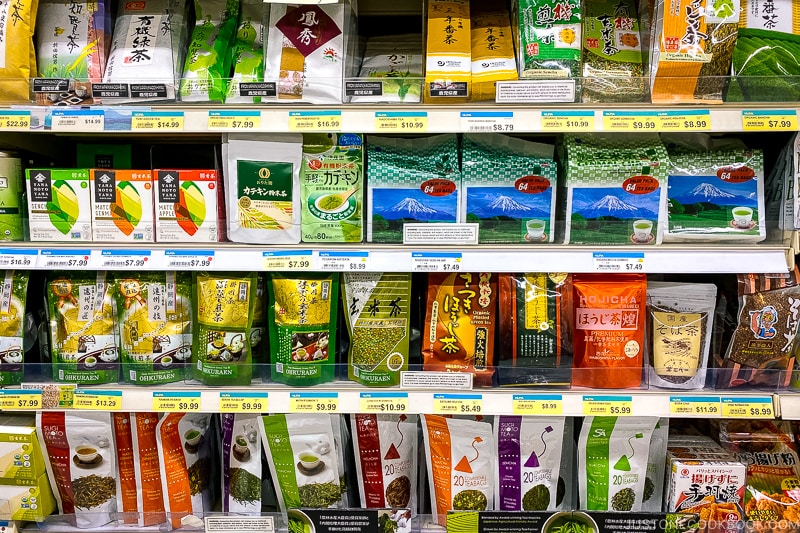
How to Choose the Best Green Tea
When choosing green tea, fresh loose leaf tea is always the best choice. Engage your senses to find the freshest tea leaves with a crisp bright aroma.
A general rule is to buy from a reliable tea producer or supplier that believes in ethical tea farming and has a strong knowledge of green tea cultivation, processing, and preparation.
👉🏼 Here are my favorite green tea shops:
- Ippodo (You can also buy their tea on Amazon: Matcha, Sencha, Genmaicha, Hojicha)
- Japanese Green Tea Co.
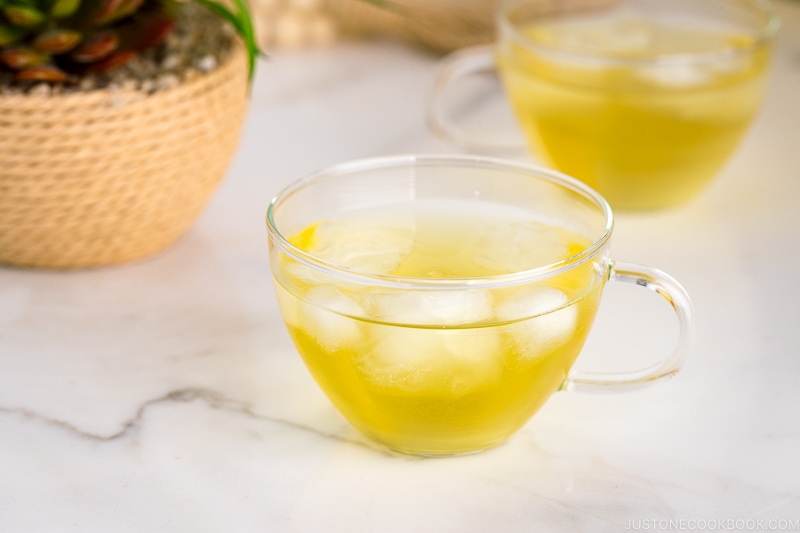
How to Make the Perfect Cup of Green Tea
In modern Western culture, green tea has become heavily associated with the matcha flavor— that is, green tea mochi, green tea ice cream, green tea cookies. However, simply drinking the tea itself remains a staple of Japanese culture.
To enjoy the benefits of green tea, here’s how to make the perfect cup of green tea:
- The ideal temperature for making green tea should be 160-180 ºF (70-82 ºC). The most common mistake many of us make when making a pot of green tea is steeping it with boiling water. Not only does the hot boiling water result in a bitter tasting green tea, it can also destroy the bioactive compounds such as catechins that are beneficial in the tea.
- The steeping time for green tea varies depending on the type and quality of the green tea you use. In general, you can steep for three minutes, then have a taste and let it steep longer if you prefer. After drinking, green tea leaves can be steeped again, usually 2-3 times.
- The Japanese believe that good water yields good rice and the same goes for a good pot of tea. The quality of your water will determine how your green tea tastes. Mountain spring water is ideal for making the best tea, but since that may not be feasible, try a high quality bottled water or at least soft water from the tap.
- Green tea is best on its own without sugar, dairy, or any added ‘natural flavors’.
- To maximize the health benefits, you can also enjoy green tea with citrus such as a squeeze of lemon juice. Vitamin C in the citrus will help your body absorb the catechins (source).
How Many Cups of Green Tea Should I Drink?
Most experts recommend drinking about 3-4 cups of green tea per day to receive the most benefits from green tea. However, if you are just starting to drink green tea, enjoy one cup in the morning after breakfast and one in the afternoon after lunch.
More Healthy Japanese Beverage:
- How to Cold Brew Green Tea
- Honey Ginger Tea (Shogayu)
- Buckwheat Tea
- How to Cold Brew Hojicha
- Amazake (Fermented Japanese Rice Drink)
Editor’s Note: This post was originally published on November 20, 2017. The post has been updated with more information and republished in March 2022.










Which tea is your favorite? Sencha? Matcha? …. which flavour?
Hi – Sencha and matcha are green tea, but both have very different qualities and flavors. Matcha comes in fine powder, and Sencha is in tea leaves form. We enjoy both very much. Sencha is more for daily drinking and matcha can be used for latte or baking.
My hands down favourite tea….Is a Kyoto speciality. Only available if you are there – or can likely order it online during a small spring window. It is a beautiful green tea – mixed with cherry blossom and cherry twigs. It does sound corny,,,but tastes superb. The company that sells it – sells out almost immediately. We have only accomplished a good size purchase once – by being in Kyoto at the right time and place. I am so tempted to go there again this spring if Japan opens up…..
Which green tea do you drink? Do you drink the normal green tea or organic is better?
Hi El – if you can access to organic green tea from Japan, that would be an ideal choice. Not all quality tea carry the certified organic label, but you can always check the source. We personally enjoy Ippodo Tea:
https://www.ippodo-tea.co.jp/en/
Japanese green tea is the best. Sri Lanka has good tea at a good price. I prefer Japanese, but there are others. I don’t worry about organic….I do believe Japanese organic claims – but don’t believe any other countries.
I love green tea, but I am new to making it myself at home. I have tried matcha at home and I love it! This may sound silly, but I particularly want to be able to make the kind of tea that is served in a Japanese restaurant. What type of green tea would this be? Or considering I enjoy that flavor, what type of green tea would you recommend?
Hi Hannah – The green tea served at Japanese restaurants are typically sencha variety. Then again, there are many different grades and quality. If you like that particular tea from the restaurant you mentioned, maybe you could ask the restaurant? Our favorite brand is Ippodo. Both their sencha and hojicha are good and you can find them on Amazon or Japanese grocery stores. You can also find online specialty tea shops that offer quality green tea. I’d say order a few different types in smaller quantity first. Everyone has different taste buds, so try out a few and see which one you’d like best.
Brew it cold. Teabags, loose tea in cold water for several hours. IF you want it hot – stick it in the microwave….but better cold. Refreshing, healthy, better taste. It is the best way. Less traditional – more real. google it. Japanese websites are there to encourage it!
Green tea discussion: do you personally drink green tea or coffee every morning?
Hi – I personally drink green tea in the afternoon, but sometimes in mid-morning or in the evening.
Lovely to know. Enjoy your tea!
[…] chá verde é um item essencial da cultura japonesa que se tornou muito valorizado ao longo dos anos por seus benefícios à saúde e simplicidade. […]
Do you steep straight after the water is boiled or wait for 5mins or so? I use 1 teaspoon of sencha and steep for 5 mins. If drink straight after breakfast is that most Japanese drink is after breakfast and lunch?
Hi El – So sorry for the delayed response. Your comment got buried in the system. Sounds like you’re doing the right thing by steeping the tea leaves for 5 minutes. Make sure the water temperature is at 175 to 185 F (to prevent burning the tea leaves and bitter taste). There is no strict time when you should drink it, but Japanese do enjoy it with breakfast or with lunch.
Cold brew for lunch or dinner and in-brtween. Try coffee for breakfast, Japanese do. Coffee also has health benefits.
Natural tea
An article! Diabliss Natural tea is a refreshing and aromatic drink made steeping the leaves in hot water. Diabliss natural Tea good for diabetic / These metabolites are present in tea plants for their natural defense, but when consumed as part of the dietary intake, they are metabolized alongside water-soluble compounds. Diabliss natural Tea good for diabetic / they either use refined sugar or artificial sweeteners which increase the glycemic index of the product
How Many cups of green tea a day is a common question for everyone who likes this tea.
Hi Kavita – There’s really no specific answer to that. Like like anything else, we suggest moderate consumption. Typical, drinking 2-3 cups of green tea a day is beneficial.
I agree. If it is a hot day drink more. It will not hurt you at all. Quite the opposite.
[…] in healthy habits and self-care. Over here at Just One Cookbook, we’re all about drinking green tea, the daily elixir of Japanese for better health. So we’ve partnered with Japanese Green Tea Company to give away their premium matcha Japanese […]
[…] tea is a beloved staple in Japanese culture that has become highly valued over the years for its health benefits and simplicity. It might […]
In the islands coconut and coconut cream is used in everything.
Detoxifying your body is the solitary way of cleansing your body of these
toxins. You can do cardio, dance, step and kickboxing in this game.
[…] : 1, 2, « Les couleurs du thé » édition […]
I recently bought a ‘Sencha Silver’ tea from a Japanese shop. Producer is Ujinotsuyu (ujinotsuyu.co.jp). No matter how I steep the leaves, I am unable to get a decent cup of tea. Beverage stays transparent and tastes like warm water. I started steeping at 74°C – 1 min then up to 3 min, no improvement. I then rised the temperature to 80°C then 85°C and today 95°C – 3min. Result is the same: transparent beverage, no flavor. How can that be ? Is this a bad quailty tea (it was pretty expensive though). What am I doing wrong ?
Hi Eric, it is most likely the tea has been on shelf for too long. You may want to contact the company to check?
Those times are a bit short, as is the temperature. If we want hot green tea (we prefer cold brew) we use 5-10 minutes……no need to hurry…..And brew about 90 degrees C at the start. Works well and is cost effective. That said tea you are battling with – sounds like rubbish, Try another one….
My favorite green tea to drink is Japanese sencha. For Ohazuke it is genmaicha. If I brew a big cup I like to use Genmaicha cause it last longer without getting bitter. For Chinese green tea My favorite is dragon well then puerh. My favorite time to drink tea is right after my meal. Especially if it was greasy.
Thanks Suz! We agree, the best time to drink tea is after a greasy and heavy meal.
This is a wonderful post. Tea is one of my biggest interests and hobbies, and the newsletter said to leave some feedback if you’re an avid tea drinker, so I have a few tips to share.
All the information is very accurate here! I think it’s a very concise article that will help people understand Japanese tea.
I had some thoughts that came to mind that weren’t specifically mentioned. I’m sure you already know these, but they might help other people who are new to Japanese tea:
– It might be helpful to mention that there is culinary quality and ceremonial/drinking quality matcha and explain the difference since most culinary matcha is a lower grade and will not taste great to drink alone (better in smoothies, baking, sweets, etc).
– Brewing Japanese green tea can be as quick as a 1-2 minute infusion, just depending how much leaves you use. Some people might experiment with shorter infusion time if they think their tea is strong or bitter (even with the right water temperature). A common mistake for people new to green tea is over-brewing it, thinking all green tea is bitter, and not trying it again. I’ve met a lot of people who think this!
– When you reinfuse tea, the 2nd infusion doesn’t need as long to steep as the first one does because the tea leaves are already hydrated and tea will extract much more quickly. I usually find that I only need about half the time of the first infusion for the second infusion, and then somewhere inbetween the two times for the third. You can go longer for the fourth infusion, but most green tea will have given up its best flavor by 3-4 infusions. The timing is somewhat a matter of preference though and of course people can experiment to get the flavor they like.
– Filtered water is also a great source of water for tea. I refill a 3-gallon jug at the water filtration stations you see at most grocery stores (eco-friendly!). It’s usually Reverse Osmosis filtered water, which is very finely filtered. It doesn’t contain the flavor, texture, and health benefits that spring water has since it isn’t full of minerals, but it has a very nice neutral taste palate that allows the tea leaves to extract easily and show their true flavor.
Thank you for this article. I am glad to see more love, education, and appreciation of tea!
Hi Lion – thanks so much for sharing your knowledge on tea! This is exactly we’d love to hear. All the tips are very useful and we’re glad that you chimed in.
Cheers mate. Lived in Japan as a kid, worked there later in life….Tea is important – but a lot more complicated than it is worth, In Okinawa we learned there is a huge difference between hot tea…and cold brew tea. Same brand, People should try that themselves. I have had hot tea that my Japanese co-workers were impressed with -that I found bitter and ordinary. And cold tea they despised and I really loved. Same brand….different temps. People should feel free to experiment. Japanese tea is very good…some Sri Lankan teas are also vey good. It is a tasteful world…